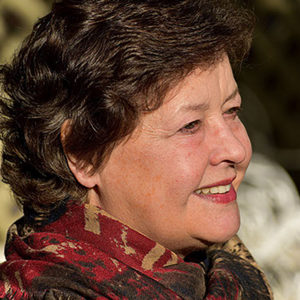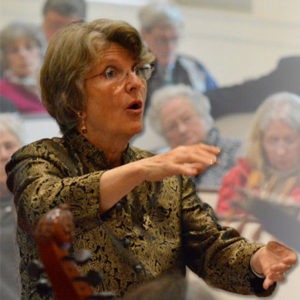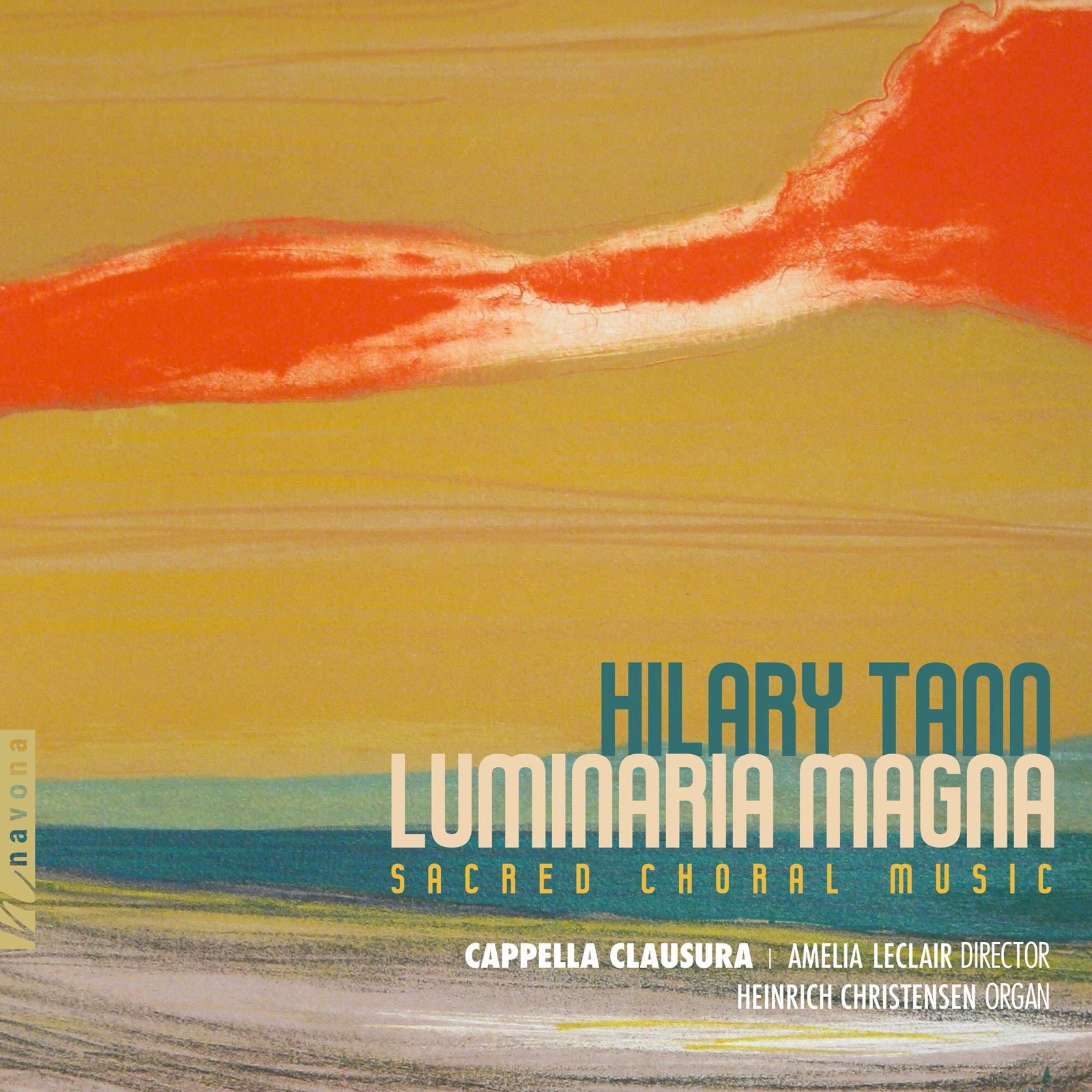Luminaria Magna
Hilary Tann composer
Cappella Clausura | Amelia LeClair director
Heinrich Christensen organ
Hilary Tann’s profoundly lyrical sacred works shine in LUMINARIA MAGNA, a striking and inspiring collection of songs featuring the voices of Cappella Clausura — led by Amelia LeClair — and the exceptional organ performance of Heinrich Christiansen. Tann’s Welsh heritage and homeland is palpable in these sincere musical devotions, transporting listeners to the foggy moorlands of South Wales. Her profound textual setting captures the rich legacy of Welsh hymnals, while simultaneously pulling text and inspiration from the Japanese Haiku and plainsong traditions. There’s no doubt that the chilling and earnest devotions of LUMINARIA MAGNA will captivate listeners in a varied and rich landscape of uniquely sacred songs.
Listen
Stream/Buy
Choose your platform
Track Listing & Credits
| # | Title | Composer | Performer | |
|---|---|---|---|---|
| 01 | Embertides: I. Advent | Hilary Tann | Heinrich Christensen, organ | 3:07 |
| 02 | The Moor | Hilary Tann | Cappella Clausura | Amelia LeClair, conductor; Janet Stone, Adriana Repetto, Shannon Larkin - soprano; Barbara Hill, Lisa Hadley, Lisa Bloom - alto | 5:02 |
| 03 | Wellspring | Hilary Tann | Cappella Clausura | Amelia LeClair, conductor; Janet Stone, Adriana Repetto, Shannon Larkin - soprano; Barbara Hill, Lisa Hadley, Lisa Bloom - alto | 3:38 |
| 04 | Embertides: II. Lenten | Hilary Tann | Heinrich Christensen, organ | 3:33 |
| 05 | Wales, Our Land | Hilary Tann | Vanessa Mulvey, flute; Cappella Clausura | Amelia LeClair, conductor; Janet Stone, Adriana Repetto, Shannon Larkin - soprano; Barbara Hill, Lisa Hadley, Lisa Bloom - alto; Francesco Logozzo, Connor Vigeant - tenors; Nathan Halbur, Thomas Valle-Hoag - bass | 4:15 |
| 06 | That Jewel Spirit | Hilary Tann | Heinrich Christensen, organ; Vanessa Mulvey, flute | 5:18 |
| 07 | Embertides: III. Whitsun | Hilary Tann | Heinrich Christensen, organ | 3:12 |
| 08 | Measuring the Distance | Hilary Tann | Barbara Hill, Francesco Logozzo - solos; Heinrich Christensen, organ; Vanessa Mulvey, flute; Cappella Clausura | Amelia LeClair, conductor; Janet Stone, Adriana Repetto, Shannon Larkin - soprano; Barbara Hill, Lisa Hadley, Lisa Bloom - alto; Francesco Logozzo, Connor Vigeant - tenors; Nathan Halbur, Thomas Valle-Hoag - bass | 6:51 |
| 09 | Children of Grace | Hilary Tann | Adriana Repetto, Lisa Bloom - solos; Heinrich Christensen, organ; Cappella Clausura | Amelia LeClair, conductor; Janet Stone, Adriana Repetto, Shannon Larkin - soprano; Barbara Hill, Lisa Hadley, Lisa Bloom - alto; Francesco Logozzo, Connor Vigeant - tenors; Nathan Halbur, Thomas Valle-Hoag - bass | 9:16 |
| 10 | Embertides: IV. Michaelmas | Hilary Tann | Heinrich Christensen, organ | 4:11 |
| 11 | Luminaria Magna (Psalm 136) | Hilary Tann | Heinrich Christensen, organ; Cappella Clausura | Amelia LeClair, conductor; Janet Stone, Adriana Repetto, Shannon Larkin - soprano; Barbara Hill, Lisa Hadley, Lisa Bloom - alto; Francesco Logozzo, Connor Vigeant - tenors; Nathan Halbur, Thomas Valle-Hoag - bass | 7:32 |
| 12 | Incline Thine Ear (Psalm 86) | Hilary Tann | Heinrich Christensen, organ; Geoffrey Shamu, trumpet; Cappella Clausura | Amelia LeClair, conductor; Janet Stone, Adriana Repetto, Shannon Larkin - soprano; Barbara Hill, Lisa Hadley, Lisa Bloom - alto; Francesco Logozzo, Connor Vigeant - tenors; Nathan Halbur, Thomas Valle-Hoag - bass | 8:33 |
| 13 | Praise, My Soul (Psalm 104) | Hilary Tann | Heinrich Christensen, organ; Geoffrey Shamu, Liz Jewell - trumpet; Cappella Clausura | Amelia LeClair, conductor; Janet Stone, Adriana Repetto, Shannon Larkin - soprano; Barbara Hill, Lisa Hadley, Lisa Bloom - alto; Francesco Logozzo, Connor Vigeant - tenors; Nathan Halbur, Thomas Valle-Hoag - bass | 7:57 |
Recorded June 13-16, 2022 at Church of the Redeemer in Chestnut Hill MA
Producer Brad Michel
Engineer Brad Michel, Lucas Paquette
Editing, Mixing & Mastering Brad Michel
Cover Image André Bergeron, RCA
Executive Producer Bob Lord
A&R Director Brandon MacNeil
VP of Production Jan Košulič
Production Director Levi Brown
Audio Director Lucas Paquette
Production Assistant Martina Watzkova
VP, Design & Marketing Brett Picknell
Art Director Ryan Harrison
Design Edward A. Fleming, Morgan Hauber
Publicity Patrick Niland
Artist Information

Hilary Tann
Welsh-born composer Hilary Tann lived in the foothills of the Adirondack Mountains in Upstate New York where she was the John Howard Payne Professor of Music Emerita at Union College, Schenectady. Her compositions have been widely performed and recorded by ensembles such as the European Women’s Orchestra, Tenebrae, Lontano, Marsyas Trio, Thai Philharmonic, Royal Liverpool Philharmonic, and BBC National Orchestra of Wales.

Cappella Clausura
Cappella Clausura was founded by Amelia LeClair in 2004 to research, study and perform the music of women composers. Our twin goals are to bring engaging performances of this music to today’s audiences, and to help bring women composers into the classical canon. Our repertoire extends from the earliest known music by women, written in the middle ages, to the music of our own time.

Amelia LeClair
Amelia LeClair, Affiliated Scholar at the Brandeis University Women’s Studies Research Center, received her Bachelor’s degree in Music Theory and Composition from UMass/Boston and her Master of Music in choral conducting from New England Conservatory, studying with Simon Carrington. She made her conducting debut in Boston’s Jordan Hall in March of 2002.

Heinrich Christensen
A native of Denmark, Heinrich Christensen received the Church Music and Soloist Diplomas from the Århus Conservatory of Music with further studies in France at the Conservatoire de Saint-Maur with Olivier Latry. After a stint as a music director in Malmö, Sweden, he came to the United States in 1998 and received an Artist Diploma in Organ Performance from the Boston Conservatory, where his teacher was James David Christie.

